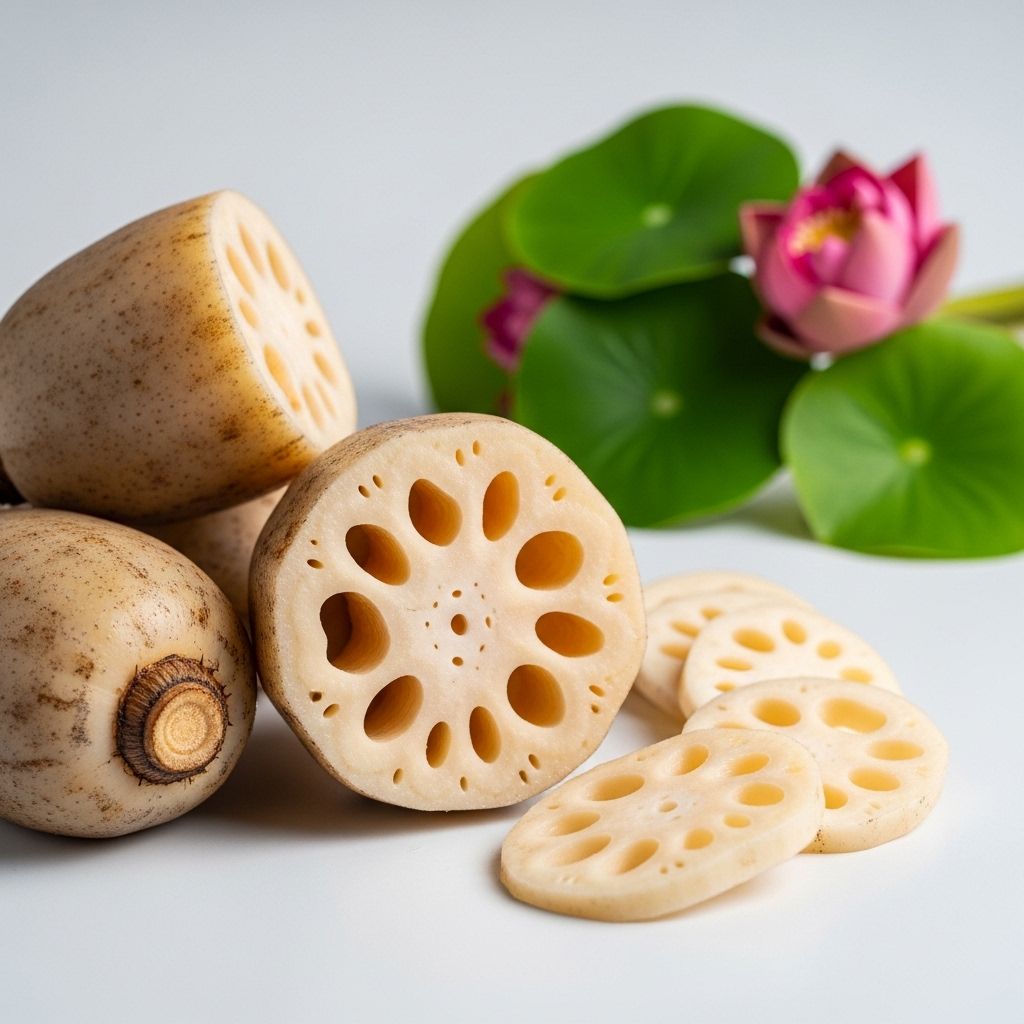Lotus Root: Nutrition, Health Benefits, Uses, and Side Effects
A crisp addition to meals that boosts gut health, skin radiance, and heart wellness.

Lotus root, commonly called renkon in Japan and kamal kakdi in India, is an edible rhizome with a remarkable nutritional profile and numerous health benefits. Used extensively across Asian cuisines and traditional medicine, this crunchy vegetable is not only delicious but also an excellent source of vitamins, minerals, and bioactive compounds.
Table of Contents
- What Is Lotus Root?
- Nutritional Profile of Lotus Root
- Key Health Benefits of Lotus Root
- Uses of Lotus Root
- How to Prepare and Eat Lotus Root
- Side Effects and Precautions
- Frequently Asked Questions
What Is Lotus Root?
The lotus root is the underwater stem, or rhizome, of the Nelumbo nucifera plant, which produces the iconic lotus flower. Characterized by its elongated, tube-like shape and unique pattern of evenly spaced holes, lotus root is both a visual and culinary delight. It features a crisp, crunchy texture, with a mildly sweet and nutty flavor that absorbs seasonings beautifully.
Nutritional Profile of Lotus Root
Low in calories yet highly nutritious, lotus root stands out as a rich source of dietary fiber, vitamins, and essential minerals.
| Nutrient (per 100g) | Amount |
|---|---|
| Calories | 79 kcal |
| Water | ~76 g |
| Protein | 1.9 g |
| Fat | 0.1-0.9 g |
| Carbohydrate | 14.7 g |
| Dietary Fiber | 4.7–4.9 g |
| Vitamin C | 26.6–44 mg (up to 73% RDA) |
| Vitamin B6 | 0.19 mg |
| Folate | 26.5 µg |
| Thiamin | 0.07 mg |
| Niacin | 0.4 mg |
| Pantothenic Acid | 0.3 mg |
| Phosphorus | 74.3 mg |
| Potassium | 611 mg |
| Calcium | ~38 mg |
| Iron | 3.3 mg |
| Magnesium | 26.6 mg |
| Copper | 0.22 mg |
| Manganese | 1.40 mg |
| Selenium | 4.6 µg |
| Zinc | 0.35 mg |
| Sodium | 20.6 mg |
Lotus root contains beneficial plant compounds such as flavonoids, catechins, gallic acid, and other polyphenols known for their antioxidant and anti-inflammatory properties.
Key Health Benefits of Lotus Root
Lotus root has long been prized not only for its taste but also for its health-promoting properties. Below are some of the key researched and traditional benefits:
1. Improves Digestive Health
- Rich in dietary fiber, lotus root supports healthy digestion by bulking up stool and promoting regularity.
- Helps alleviate constipation and supports healthy gut microbiota.
- The fiber content promotes satiety, contributing to weight management and appetite reduction.
- Contains phenolic compounds that may improve gut health by supporting good bacteria and reducing inflammation.
2. Promotes Healthy Skin
- High in vitamin C, lotus root plays a crucial role in collagen synthesis, supporting skin elasticity and reducing signs of aging such as wrinkles and hyperpigmentation.
- Its antioxidant activity helps protect cells from free radical damage and oxidative stress, resulting in a brighter, clearer complexion.
3. Supports Cardiovascular Health
- Potassium content helps regulate blood pressure and promotes a healthy heart rhythm.
- High fiber and low fat profile support healthy cholesterol levels by reducing LDL cholesterol absorption.
- Antioxidant and anti-inflammatory compounds in lotus root help prevent atherosclerosis and protect blood vessels.
4. Enhances Immunity
- Loaded with vitamin C, which stimulates immune cell production and boosts overall immune defenses.
- Polyphenols such as catechins and gallic acid further enhance immune resilience.
5. Increases Energy Levels
- Provides a steady supply of complex carbohydrates, supporting sustained energy release.
- Rich in iron and copper, important for red blood cell formation and oxygen transport, preventing tiredness and anemia.
6. Benefits Brain Health
- Contains copper and polyphenolic compounds, which may boost neural function and improve cognition.
- Essential B vitamins support neurotransmitter synthesis and nerve health.
7. Helps Control Blood Sugar
- The low glycemic index and high fiber content help regulate blood sugar levels, making lotus root suitable for diabetics when consumed in moderation.
8. Supports Weight Management
- High water and fiber content provide satiety, helping reduce calorie intake and manage body weight.
- Very low in calories and almost no fat.
Uses of Lotus Root
Culinary Uses
- Lotus root is renowned in Asian cuisines—stir-fried, boiled, pickled, fried, or added to soups and curries.
- Its crunchy texture makes it suitable for salads as well as tempura-style deep-frying.
- Dried and powdered forms are also used for thickening sauces and drinks.
- In Japan, sliced lotus root symbolizes good fortune and is served at celebrations.
Traditional Medicine
- Widely used in Ayurveda, Chinese medicine, and other traditional systems for its health-promoting properties.
- Recommended for respiratory conditions, digestive issues, and boosting overall vitality.
- Lotus leaves, seeds, and stems are also used for their unique medicinal effects.
How to Prepare and Eat Lotus Root
Fresh lotus root can be found in Asian grocery stores year-round. When buying, look for firm, unblemished roots. Avoid those that feel soft or have dark spots.
- Before using, peel the skin and rinse thoroughly.
- Slicing reveals a beautiful pattern of holes; these slices can be used directly in cooking.
- To prevent discoloration, soak cut slices in vinegar or lemon water.
- Lotus root is delicious boiled, stir-fried with spices, deep-fried as chips, or simmered in stews.
- Pickled lotus root is a popular side dish in many cultures.
- It can also be blended into smoothies or blended into batters for pancakes and fritters.
Side Effects and Precautions
Lotus root is generally safe for most people when consumed as part of the diet. However, a few precautions are worth noting:
- Always cook lotus root thoroughly—raw root may harbor parasites or bacteria, especially if grown in contaminated water sources.
- Excessive consumption of fiber can lead to gastrointestinal upset such as bloating or gas in sensitive individuals.
- Rarely, some people may be allergic to lotus root or related plants—discontinue use if any allergic reaction occurs.
- Packed or pickled lotus root may contain high sodium—consume in moderation, especially if you have hypertension.
- https://draxe.com/nutrition/lotus-root/
- https://www.nutrition-and-you.com/lotus-root.html
- https://happytummy.aashirvaad.com/en/healthy-eating/lotus-roots-benefits/
- https://www.lybrate.com/topic/benefits-of-lotus-root-and-its-side-effects
- https://sakura.co/blog/lotus-root-everything-you-need-to-know
- https://www.healthline.com/health/8-uses-for-lotus
- https://pmc.ncbi.nlm.nih.gov/articles/PMC2994372/
- https://www.urmc.rochester.edu/encyclopedia/content?contenttypeid=76&contentid=11255-2
Frequently Asked Questions (FAQs)
Q: What does lotus root taste like?
A: Lotus root has a mild, slightly sweet flavor with a crisp, crunchy texture, often compared to fresh water chestnuts or potatoes.
Q: Can you eat lotus root raw?
A: It is recommended to cook lotus root before eating to eliminate microbes or parasites that may be present.
Q: Is lotus root good for diabetics?
A: With a low glycemic index and fiber-rich profile, lotus root can be part of a diabetic-friendly diet when consumed in moderation.
Q: How do you store fresh lotus root?
A: Store unpeeled lotus root in a cool, dry place or in the refrigerator. Once peeled or sliced, keep in water with vinegar or lemon juice and refrigerate; use within a few days.
Q: Are there any cultural or symbolic meanings associated with lotus root?
A: Yes, in many Asian cultures, lotus root is a symbol of purity, fertility, and prosperity, making it a popular food during festivals and celebrations.
References
Read full bio of Sneha Tete











